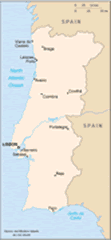National Energy Grid
|
|||||||||
 |
||
|
Full Size Map National Electricity Transmission Grid of Portugal(25 kb) |
||
GRID SUMMARY
Portugal has extremely limited domestic energy resources, and therefore imports about 90% of its energy needs. Because of Portugal's geographic location, bordering only Spain and the Atlantic Ocean, much of its energy imports are transported through Spain. The Iberian peninsula has an extensive natural gas network that links the two countries with Algeria via Morocco. The two Iberian countries signed an agreement in November 2001 to integrate their electricity markets completely by 2003. Both governments recently decided to extend the completion of the integrated market until 2006.
In 2001, Portugal consumed 41.5 billion kilowatthours (Bkwh) and generated 44.3 Bkwh of electricity. Hydropower accounted for about 31.4% of Portugal's total electricity generation in 2001, a substantial increase from 17% in 1999, a year characterized by particularly dry weather. Likewise, Portugal's oil and coal consumption for power generation fell in 2001 to about 64.5% from 79%; thermal power and hydropower tend to exhibit an inverse relationship in Portugal.
During the 1990s, installed capacity for both hydropower and thermal (coal, oil, and natural gas) grew, 36% and 47% respectively. While installed capacity for fuel oil decreased during the period, natural gas, which did not become a major source for electricity generation until 1998, increased. As of 2000, installed capacity for natural gas represented over 10% of total installed capacity and is expected to increase.
The Portuguese electricity grid is connected with Spain's and consists of 44,127 miles of high/medium voltage transmission lines and 69,640 miles of low voltage transmission lines. Up to 10% of demand could potentially be imported from and/or through Spain (and vice-versa). Despite rapidly increasing energy consumption (6% per year average 1973-1998), Portugal still has the lowest per capita power consumption in the EU, as of 2001. Portugal's electricity market is due to be fully opened to competition by July 2004.
With rising electricity demand and large-scale hydroelectric power already maximized, Portugal will most likely have to build more thermal plants, increase imports, or rely more on renewable sources of electricity such as wind, solar, co-generation, and mini-hydroelectric plants. The Portuguese government aims to increase electricity generation from renewable sources by 40% during the period 2002-2010. Portugal produced 1.8 Bkwh from renewable sources (excluding hydro) in 2001.